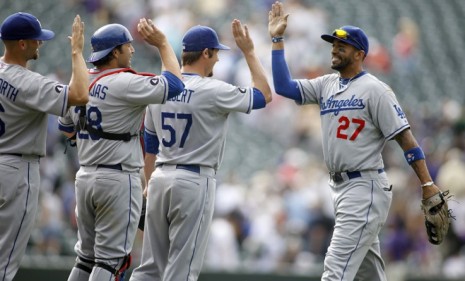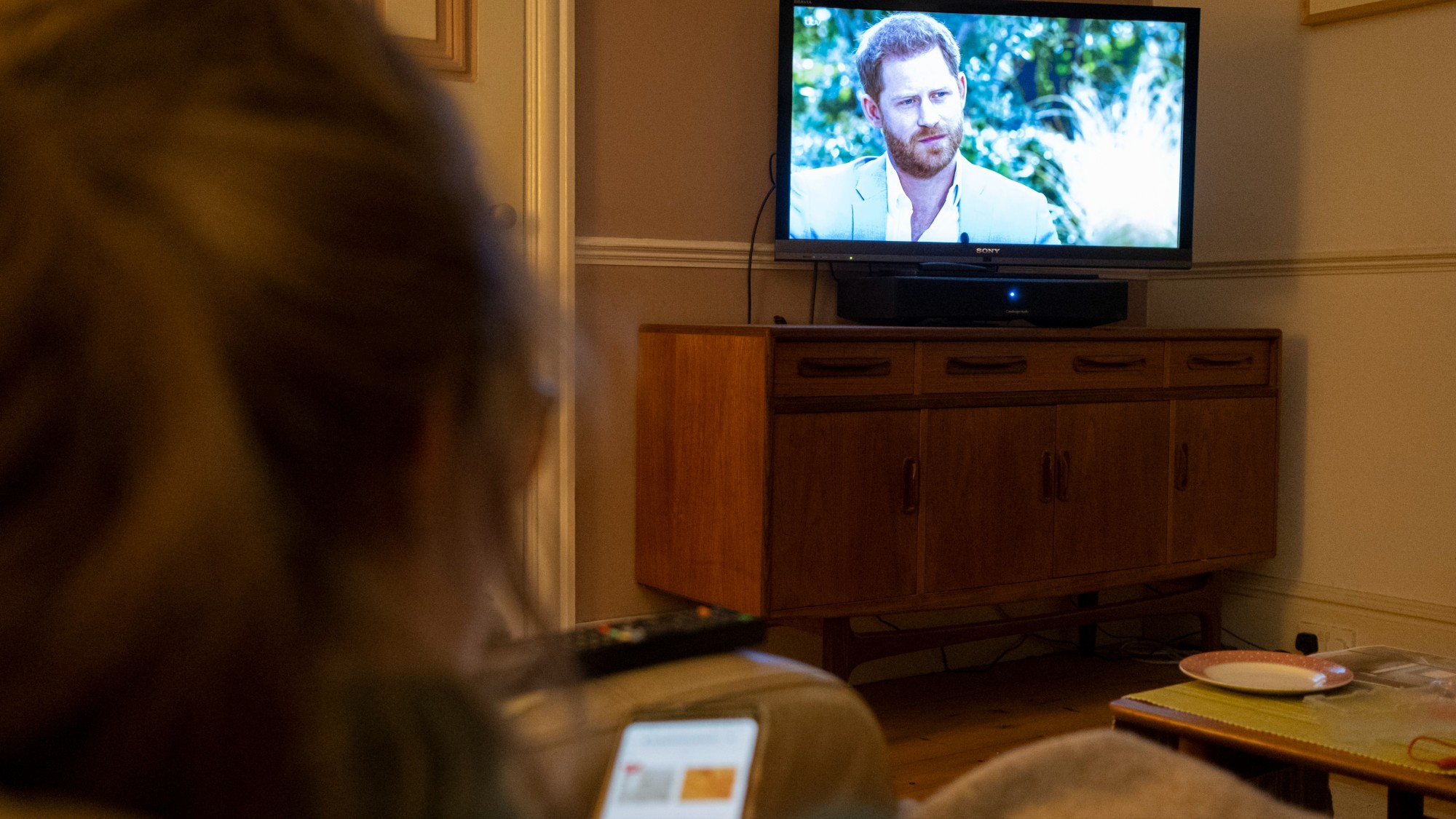The birth of the high five
Who invented the celebratory gesture? A baseball player who was later shunned by the sport, says Jon Mooallem

IT WAS OCT. 2, 1977, the last day of the regular season, and Dodgers left fielder Dusty Baker had just gone deep off the Astros' J.R. Richard. It was Baker's 30th home run, a wild, triumphant moment as the Dodgers headed to the playoffs. Glenn Burke, a young outfielder whose astonishing physique and 17-inch biceps earned him the nickname King Kong, was waiting on deck. In front of 46,000 screaming fans at Dodger Stadium, Burke thrust his hand enthusiastically over his head to greet his friend at the plate. Baker, not knowing what to do, smacked it. "His hand was up in the air, and he was arching way back," says Baker, 62, who's now managing the Cincinnati Reds. "So I reached up and hit his hand. It seemed like the thing to do."
Burke then stepped to the plate and launched his first major league home run. And as he returned to the dugout, Baker high-fived him. From there, the story goes, the high five went ricocheting around the world. This simple, timeless gesture, it seems, was invented then and there in Dodgers Stadium by Burke, though sadly the game was not televised, and no footage survives of the first man to go up top.
The high five was a natural outgrowth of Burke's personality. The Oakland native was an irrepressibly charismatic man who, even as a 24-year-old rookie that season, had become the soul of the Dodgers' clubhouse. He did Richard Pryor stand-up from memory and would stuff towels under his shirt and waddle bowlegged around the dugout, imitating Dodgers manager Tommy Lasorda. "He was a joyous, gregarious person," says sports agent Abdul-Jalil al-Hakim, a friend since childhood.
Subscribe to The Week
Escape your echo chamber. Get the facts behind the news, plus analysis from multiple perspectives.

Sign up for The Week's Free Newsletters
From our morning news briefing to a weekly Good News Newsletter, get the best of The Week delivered directly to your inbox.
From our morning news briefing to a weekly Good News Newsletter, get the best of The Week delivered directly to your inbox.
What most people didn't know was that Burke was gay. Following his retirement, in 1980, he became the first major leaguer to come out. Even though he tried to keep his sexuality a secret during his playing days, there had been rumors in the clubhouse. And as the 2010 television documentary Out: The Glenn Burke Story revealed, Dodgers executives scrambled to squash those rumors at all costs: In the off-season of 1977, team VP Al Campanis offered Burke $75,000 to get married. According to a friend, Burke rejected the marriage deal with a mix of wit and rebelliousness. He told Campanis, "I guess you mean to a woman."
It was around that time that Burke struck up a relationship with Spunky Lasorda, aka Tommy Lasorda Jr. Spunky was a lithe young socialite who frequented West Hollywood's gay scene, smoking cigarettes from a long holder. A 1992 GQ profile of Spunky portrayed his homosexuality as an open secret. But his father was in staunch denial and remained so even after Spunky's death, in 1991, from pneumonia. GQ reported that the death certificate said his illness was likely AIDS-related. "My son wasn't gay. No way," Lasorda Sr. told the magazine.
Burke and Spunky's relationship didn't become public until years later and remains ambiguous. Burke's sister, Lutha Davis, insists the two men were just close friends. In his 1995 memoir, Out at Home, co-authored with Erik Sherman, Burke went out of his way to leave the true nature of the relationship unclear. "That's my business," he wrote. He also explained that Lasorda Sr.'s homophobia was something he and Spunky commiserated about. Burke described them turning up together at Lasorda's house one night, done up in pigtails and drag, hoping to stage a kind of gay Guess Who's Coming to Dinner. They chickened out before knocking on the door.
Whatever the case, Burke's association with Spunky marks the point at which his big league career took an irrevocable left turn. Lasorda stopped being amused by the player's dugout antics and, according to Burke, turned on him. "Glenn had such an abundance of respect and love for Tommy Lasorda," says Burke's sister. "When things went bad at the end, it was almost like a father turning his back on his son." Early in the 1978 season, the Dodgers abruptly dealt Burke to the Oakland A's — among the most lackluster teams in baseball — for Billy North, an outfielder past his prime. L.A. sportswriters described the trade as sucking the life out of the Dodgers' clubhouse. A couple of players were seen crying at their lockers.
A free daily email with the biggest news stories of the day – and the best features from TheWeek.com
For Burke the trade had everything to do with his sexuality — though the outfielder sounded off to the press about it in only the most cryptic terms. "I never got a chance here," he said. "I felt I was supposed to kiss ass and I didn't."
After unproductive years in 1978 and '79, Burke hoped for a fresh start in 1980 under new A's manager Billy Martin. But the gay rumors followed Burke to Oakland. Martin threw the word "faggot" around the clubhouse and didn't play Burke. Some teammates even avoided showering with him. Burke, accustomed to being the heart of the clubhouse, felt crippled by the discomfort he was causing. His unhappiness was compounded by a knee injury and a demotion to Triple-A. After playing just 25 games in the minors in 1980, he abruptly retired. He was 27 years old. "It's the first thing in my life I ever backed down from," he later said.
Burke started hanging around San Francisco's Castro district. He became a star shortstop in a local gay softball league and dominated in the Gay Softball World Series. "I was making money playing ball and not having any fun," he said of his time in the majors. "Now I'm not making money, but I'm having fun." Jack McGowan, a friend in the Castro who has since passed away, once said of Burke: "He was a hero to us. He was athletic, clean-cut, masculine. He was everything that we wanted to prove to the world that we could be."
In the Castro, Burke's creation of the high five was part of his Herculean mystique. He would flash his magnetic smile and high-five everyone who walked by. In 1982, he came out publicly in an Inside Sports magazine profile called "The Double Life of a Gay Dodger." The writer, a gay activist named Michael J. Smith, appropriated the high five as a defiant symbol of gay pride. Rising from the wreckage of Burke's aborted baseball career, Smith wrote, was "a legacy of two men's hands touching, high above their heads."
By that time, however, Burke was struggling with a drug habit. It escalated in 1987, when a car plowed into him as he was crossing a street, breaking his right leg in four places and stealing his athleticism. He couldn't hold a job. He went broke. He did some time at San Quentin for grand theft. Then, in 1993, he tested positive for HIV. He passed away on May 30, 1995, after a sharp and grisly decline. One obituary noted that, at the end, the man who invented the high five "could barely lift his arm."
As Burke's life sputtered downward, the high five madly ascended. Even by 1980, the Dodgers were selling "High Five" T-shirts with a trademarked logo of two upraised hands connecting. It wasn't just L.A. The high five was being celebrated as a welcome injection of style throughout sports and in everyday life. "The high five liberated everybody," says Abdul-Jalil al-Hakim. "It gave you permission to enjoy your high points." And not just in sports but at your kid's spelling bee or your office after a killer PowerPoint presentation. In this interpretation, Burke didn't just add a bit of flair to baseball, he uncorked a repressed longing for personal expression and connection in all of American society.
Years after Burke died, his sister Lutha Davis was watching Jeopardy! when a question about the inventor of the high five popped up. People who knew Burke have always known "the truth," she told me, but it was gratifying to watch some anonymous, Midwestern-looking contestant buzz in and say, with unflappable certainty, "Who is Glenn Burke?"
IT'S NICE TO believe that something as magnificent and durable as the high five could be invented only once, in a romantic, unforgettable flash. The truth is, such things are invented many times, by many people — multiple mythologies rewritten over time. I've come to realize this because in my search for the first high five, I happened upon a second entirely credible story of its birth. It goes like this: At a University of Louisville basketball practice during the 1978–79 season, forward Wiley Brown went to give a plain old "low five," a knee-high hand slap, to his teammate Derek Smith. Out of nowhere, Smith looked Brown in the eye and said, "No. Up high."
The Louisville Cardinals were known as the Doctors of Dunk. They played above the rim. So when Smith raised his hand, it clicked for Brown: He understood how the low five went against the essential, vertical character of their team. "I thought, 'Yeah, why are we staying down low? We jump so high,'" says Brown, now head coach at Indiana University Southeast. Brown insists it was Smith who invented the high five and Smith who spread it around the country.
In fact, high fives do turn up in highlight reels of the 1978–79 Louisville team. Occasionally, they're jerky, thrusting fives — more like spears thrown perpendicularly at the other guy's torso — but they're clearly among the first high fives ever broadcast into American living rooms. I couldn't ask Derek Smith about his invention of the high five. After a respectable NBA career, he died suddenly in 1996 from an undiagnosed heart condition. But Brown told me about one particular day at Louisville, after Smith got a call about the high five from a big-city newspaper. "Derek was talking about how this was going to go down in history," Brown says. "It would be something we could tell our kids and grandkids."
A tiny item in The New York Times on Sept. 1, 1980, mentioned a burgeoning fad called the high five and the man who apparently invented it, Derek Smith. There's no mention of Glenn Burke, even though he also apparently invented the high five three years earlier. In fact, aside from Smith and his teammates, there's only one other person mentioned in the story. The piece begins: "Manager Tom Lasorda of the Los Angeles Dodgers has joined the growing list of 'high fivers'....But the veteran of 35 years in baseball admits he does not know where it all began." It's just one of those things, Lasorda told the paper. "Who knows?"
So here's the question: Did Lasorda purposefully not mention Glenn Burke? Through an assistant, Lasorda reiterated that he doesn't know who invented the high five but didn't respond to requests for an interview. So, ultimately, the story of the high five is a ghost story, about how we remember and how badly we want to be remembered.
Glenn Burke walked away from baseball after four seasons with a career .237 batting average. But as he told a newspaper reporter years later: "You think about the feeling you get when you give someone the high five. I had that feeling before everybody else."
By Jon Mooallem. ©2011 ESPN The Magazine. Reprinted with permission.
-
 Evita: 'TikTok musical theatre' or 'total triumph'?
Evita: 'TikTok musical theatre' or 'total triumph'?Talking Point Rachel Zegler dazzles in Jamie Lloyd's 'radically reconceived' revival – but the plot is difficult to follow
-
 Netflix and the second screen phenomenon
Netflix and the second screen phenomenonIn The Spotlight Programme makers claim they're being asked to cater for distracted viewers
-
 How will Labour pay for welfare U-turn?
How will Labour pay for welfare U-turn?Today's Big Question A dramatic concession to Labour rebels has left the government facing more fiscal dilemmas